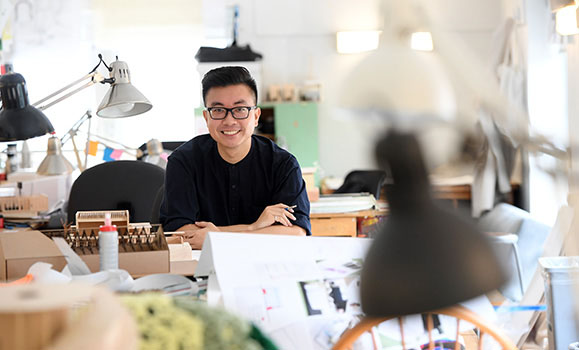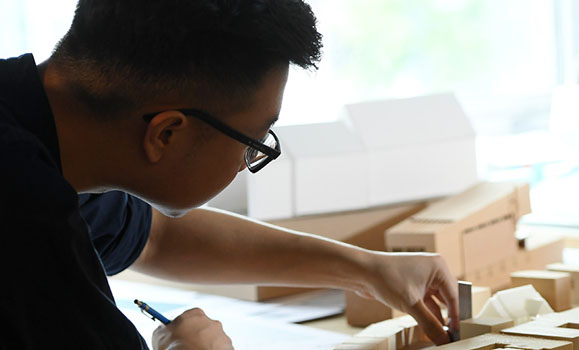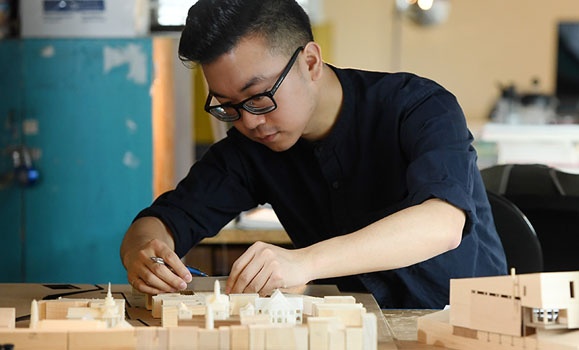Master of Architecture student Aaron Szeto is discovering the many ways that architecture can improve people’s lives.
“For me, architecture really balances using my creative skills with helping other people,” he says. “It’s about designing built environments that shape the way we live. It's also a way of analyzing spaces and improving how humans can inhabit them.”
Immersed in research
For his thesis, Aaron has been exploring how architecture can address the issue of flooding in deltaic communities. As a recipient of the Bruce and Dorothy Rossetti Scholarship, Aaron decided to travel to flood-prone Thailand to conduct his research. While he was there, he made several connections in the local architecture community who helped him navigate the area.
“I got recommendations on where to go and who to meet with to better understand the Chao Phraya Delta in Thailand,” he recalls. “People were very gracious in helping me to arrange rides in rural areas as well. I had a lot of unplanned but really great experiences there.”

While in Bangkok, Aaron observed how the urbanization of the city has resulted in an increase of concrete hardscapes that trap water during heavy rainfalls, and he began envisioning ways to use traditional landscapes to alleviate the issue.
“One of the things I worked on was studying how water could be brought back into the city by daylighting the old canals,” he explains. “I also looked at temple compounds as places to collect, retain, and release water because of their historic connection to the canal system. Thresholds were then developed where people can interact with water as they move between the temple to the canal.
“There's a cleansing aspect to the design as you go through the spaces, as well as an offering aspect. The Thai have lost this connection due to the loss of water in their urban structures, so it’s a way to not only physically bring water back into the temples and the city, but to reconnect the people with their spirituality and their culture.”
Local viewpoints
Aaron also had a chance to experience other cultures and environments with his various studio courses and electives. Throughout the four-year Professional Architecture Program, he has travelled to Portugal, through the East Coast of the United States, and to Cuba — gathering valuable perspective.
“I think the design studios at Dal offer a diversity that is very important to the pedagogy of architecture. They teach you how to analyze different urban conditions at multiple scales,” he says.

“Portugal really stood out for me because it was my first experience abroad with Dal as part of our summer Free Labs. We went there with our professor Cristina Verissimo, who does a lot of research and experimentation with cork as it is a very common material and resource in Portugal. It was a really eye-opening experience.”
A glimpse at work life
Aaron’s travels didn’t stop there. He also chose to pursue co-op placements on the West Coast of Canada. In the second year of his program, his work term took him to in Victoria, BC. This opportunity gave him a great overall understanding of the daily operations in an architectural firm. By the time he showed up for work at his second co-op, Aaron was a couple more years in and able to bring more experience to the table.
“ in Vancouver was an exciting opportunity for me to take a bit more initiative,” he recalls. “I was really fortunate because my supervisor got me involved in many projects. I felt like I was contributing to a lot of the decision-making, which was really rewarding, especially as a student about to enter the workplace.”
Seeing beyond
Back in Halifax, Aaron has been actively involved with the Dalhousie Architecture Students Association (DASA). In addition to being class rep throughout his entire program — mediating with the faculty on behalf of his fellow students — he also took on the role of DASA President.

“It’s really great to get involved in a leadership position during the year,” he says. “We're often in our own bubble here, so it’s a good chance to get engaged with other students and to see the faculty as part of a larger community.”
Aaron completed his thesis this summer and will be graduating in October. Looking back, he names his co-op work terms, travel opportunities, and conferences as the main highlights of his education.
“I think that opportunity to actually go out and see all the various ways that people are responding to different issues is really helpful to me as a young architect because I can learn from these situations and apply them to my future work in Canada.”

